Role of land set-up systems on soil (physicochemical) conditions

HTML: 45
All claims expressed in this article are solely those of the authors and do not necessarily represent those of their affiliated organizations, or those of the publisher, the editors and the reviewers. Any product that may be evaluated in this article or claim that may be made by its manufacturer is not guaranteed or endorsed by the publisher.
Land reclamation and drainage networks represent one of the most ancient human modifications of the Italian soilscape, where tailored land set-up systems were developed in agro- and forestecosystems in three millennia of man’s activity. Most of once manually maintained land settings are currently scarcely working or even disappeared because of the cost needed for their maintenance and the advent of mechanization that have simplified the field organization. The scarce attention to the soil experienced in the last decades, has accelerated soil erosion and flooding events, which entailed high costs in terms of money and human lives, but also caused reduction of soil thickness, water holding capacity, and fertility. In view of a sustainable agriculture, it is mandatory to assess the role of land set-up systems, which for centuries have been key in protecting soil from erosion, but also in increasing soil fertility. Such an effort cannot be made without considering the different pedo-climatic conditions and land uses of the Italian territory, which is different with respect to the past because of the multiple transformations made to favour the mechanization of agriculture. In this review we discuss the main effect of Italian land settings on the soilscape and on soil physicochemical conditions. Since land settings were developed centuries ago, detailed information about their effect on specific soil parameters is scarce in the scientific literature; thus, in some case, we provide information gathered in places where land set-up systems are still present.
Highlights
- Land set-up systems increase soil fertility.
- Land set-up systems reduce incidence and seriousness of flooding events.
- Land set-up systems need improvement for forest ecosystems.
- Each soilscape needs its own land set-up system.
How to Cite
PAGEPress has chosen to apply the Creative Commons Attribution NonCommercial 4.0 International License (CC BY-NC 4.0) to all manuscripts to be published.

 https://doi.org/10.4081/ija.2020.1766
https://doi.org/10.4081/ija.2020.1766







